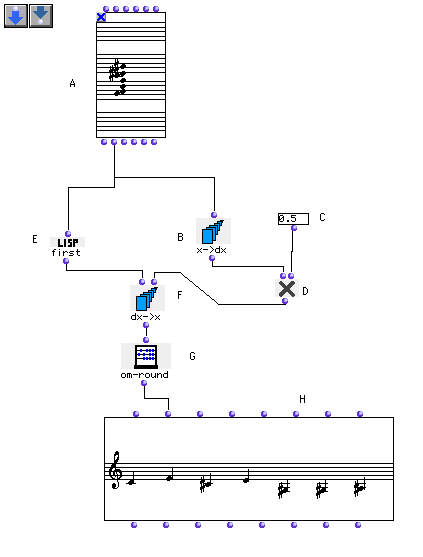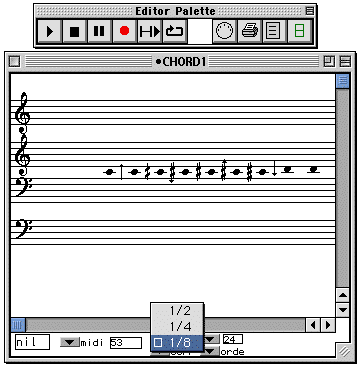OpenMusic Tutorials
Prev| Chapter 1. Using Musical Objects I| Next
Tutorial 7: Changing melodic contour
Topics
A melody form is compressed or expanded vertically by a set amount.
Key Modules Used
Chord, Chord-seq,
dx->x, x->dx, first,
om*, om-round
The Concept:
Here we’ll take a group of notes ordered in time as a melodic contour that we
want to play around with. The midic values of the notes are taken from the
Chord object, converted into relative intervals with
x->dx, and multiplied by a scaling factor. The result is
converted back into absolute values and passed back to a Chord-
seq module.
The Patch:

The ‘trick’ in this patch is the use of x->dx and
dx->x to convert back and forth between absolute pitch and
relative intervals. x->dx (B) converts the midics of the
Chord to intervals, which are multiplied (D) by a scaling
factor (C). The result is reconstructed with the help of first
and dx->x to start on the original first note.
The multiplcation factor (C) can be any number. Entering numbers smaller than 1 but greater than zero will make the intervals smaller. Entering numbers larger than 1 will make the intervals larger. Entering values smaller than zero will, as we saw in the last tutorials, invert the interval sequence.
The first box takes the midic of the first note of the
Chord, which is not necessarily the lowest- remember, the
Chord returns notes in the order they were entered, not the
order in which they occur in the chord.
The om-round function rounds any number to the nearest
whole number. To check this, change the multiplier at (C) to something with
lots of decimals, .7654321 for example. The midics that it returns will have
lots of decimals. om-round changes them into integers
(whole numbers) before transmission to the Chord-seq
object. This is unecessary. As mentioned earlier, the music object editors
have an automatic ‘rounding function’ for display purposes. Try this: Drag a
connection from the output of the dx->x function directly to
the second input of the Chord-seq. Evaluate (by option-
clicking) the output of dx->x to make sure the results have
lots of decimals. Evaluate the second output of the Chord-seq object. The decimals are still there, right? Even though your midics
were not multiples of 100, the Chord-seq object displays
notes as if they were rounded off- this is only for display and does not
affect the data itself.
Now, open the Chord-seq editor. From the pull-down menu, select 1/4 from the list:

You’ll notice some of the notes changing because their original midics were closer to quarter-tones than to semi-tones. Change it to 1/8 and you’ll probably see some more notes change to the more exact 8th-tone temperament.
Prev| Home| Next
—|—|—
Tutorial 6: Four basic operations on a 12-tone row| Up|
Tutorial 8: Construction of a harmonic series